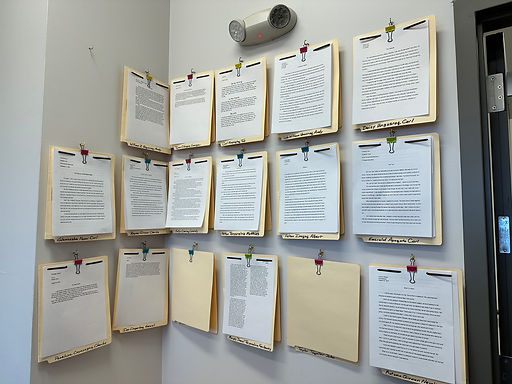
Writing
LKSD Best Practice #16: Students engage in writing in all subjects, every day
There are many different types of writing to choose from in our classrooms: reflective, journal, structured, and free. Writing should be entirely original and student generated thought.
Reflective writing takes the form and feel of a journal or diary in that students should be able to look back and review what they did in previous lessons.
Focus Friday: January 27, 2023
EOY Writing Goals
Pre-Kindergarten
By the end of the year, students will be able to
write one complete sentence in 8- 10 minutes
Kindergarten
By the end of the year, students will be able to:
-
write one *new* complete sentence each month
-
write a total of 9 sentences in 15 minutes
9+ Sentences -> Multiple Pages
1st Grade
By the end of the year, students will be able to:
-
read on grade level
-
write one full page with an increased complexity from kindergarten
-
15- 20 minute time frame
2nd Grade
Write 9+ sentences or multiple pages:
-
Fall semester, 15 minutes
-
Spring semester, 12 minutes
3rd- 12th Grade
Write 9+ sentences or multiple pages in 10 minutes
Key points to consider:
-
Students should have separate journals for language arts, math, science and social studies
-
Reflective writing should occur everyday and include academic vocabulary from the lesson's objectives or classwork

Students should have separate journals for math, science, social studies and language arts

Use sentence stems & frames to support and students' writing

Journals are a place for students to organize their thinking and reflect on what they learned

Students should have separate journals for math, science, social studies and language arts
Types of Writing
Structured:
-
How it's said VS What is said
-
Focus on grammar
-
Punctuation is stressed
-
Emphasis on "correct" writing
-
Less creativity
Free:
-
What is said VS How it's said
-
Punctuation is NOT stressed
-
Facilitates skill retention
-
More creativity
-
More (volume)
"One Word Essay"
Free Writing Strategy
Teacher Showcase

I've been working with the class on writing using journal exercises. I give a one-word prompt, and the students write for 15 minutes.
Students are instructed not to worry about form and spelling; just write.
Since August, the students have increased the amount they can write in the allotted time. They're building their ability to imagine and write.
Teacher Abigail Schwerin, Platinum

Looking to differentiate or spice things up a bit?
-
Step 1: Assign writing task (250 words or 5 paragraph essay)
-
Step 2: Students write an essay centered around the one word you provide
-
Example: Write a 5 paragraph essay focused around the word "blue"
-
-
Step 3: Students complete the assignment and turn in
-
Step 4: Teacher reads the papers with two things in mind:
-
Assess creativity and interesting value
-
Teacher does *not* correct the papers
-
-
Step 5: Teacher anonymously reads out loud the 3 "most creative/ different" papers
-
Step 6: Students can quietly guess who the author was; teacher quietly returns those three papers to their original owners as positive reinforcement
-
Step 7: Teacher returns the remaining papers to the class
If we put a limit on our expectations, that's all they're going to give us.
One Assignment: Parallel Effort
When working in pairs, we recommend partners use a different color (pen, marker, etc).
-
PreK: pairs write one letter at a time
-
KG: pairs write one word at a time
-
Grades 1- 12: pairs write one sentence at a time
-
Students are NOT allowed to copy from their partner
-
Students are NOT allowed to do their partner's work for them

In this example, Partner A used the purple marker while Partner B used the orange one.
Progression

When we compile and showcase students' writing, it provides students the opportunity to reflect and see how their skills have grown over time.
Credit: The teachers of Mertarvik